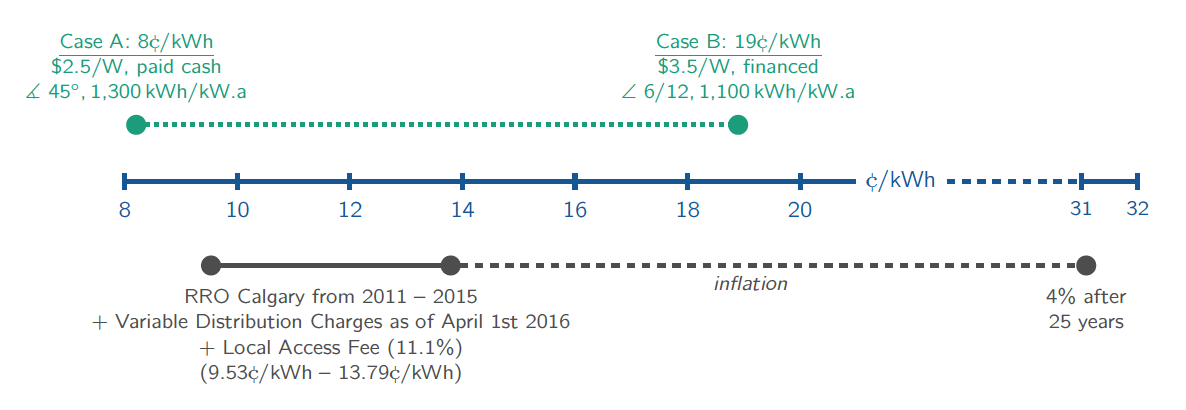Economics of Solar Power in Alberta
There are two main ways we can assess the economics of solar power in Alberta. One is by treating it like any other investment and estimating its financial payback, which is discussed here. Another method is by comparing the cost of solar electrical energy with the cost of electrical energy purchased from the utility. This is known as a levelized cost analysis, which we will look at more closely here.
Click here to view this page as a .pdf.
Levelized Cost Approach
Grid-tied solar photovoltaic systems (commonly referred to as solar power systems) in southern Alberta can provide energy at a lower rate than what utilities are charging. There are over 1,300 solar power systems connected to the grid in Alberta and the number of systems being added is in exponential growth. (More than 50% of the total capacity was installed just in the past two years.)
Unfortunately many Albertans do not believe or know how solar power can help them save money. Many see it as a niche technology with a bulky upfront cost and with little incentive other than being green. The reality is that more and more homes and businesses in Alberta are adopting solar power on straight economics. If your home or business incurs large power bills due to high energy consumption and is subject to energy spikes in high intensity months then you should consider solar power as an alternative energy source. In this post we will compare the cost range of electrical energy produced by residential grid-tie systems with what homes in Calgary are being charged for grid energy, and show that however Albertans choose to fi nance their solar power system they will spare much more money than its initial cost.
Cost of Grid Energy in Alberta
Our power bill is composed of various charges including cost of energy, cost of delivering that energy, local access fees and retailer administrative fees. The cost of energy is not the only variable component in the power bill. Below is a breakdown of the variable charges of a power bill in Calgary. As you can see delivery charges, which includes transmission and distribution, as well as local access fees also include variable components as well.

VARIABLE COST OF GRID ENERGY IN CALGARY INCLUDING COST OF DISTRIBUTION, TRANSMISSION AND LOCAL ACCESS FEE, COMPARED TO THE LEVELIZED COST OF A GRID-TIED SOLAR POWER SYSTEM IN ALBERTA.
Cost of Solar Energy in Alberta
When one purchases a solar power system they are purchasing 25+ years worth of electrical energy. To be able to compare the cost of energy that a solar power system delivers with what utilities are charging we have to calculate its levelized cost of energy (LCOE). LCOE is a power system’s average cost of generating one unit of energy. Solar power systems are maintenance free and incur no operating costs because they depend on a renewable resource. Therefore their levelized cost will depend on their installation cost (together with applicable financing costs) and output.
Residential Solar Power Example
Below we will look at the range of residential solar power’s levelized costs in southern Alberta. Please note that the analysis is done a per kilowatt basis and not by total system size since every solar power installation is different and up to the owner’s discretion. Four standard solar modules (which are commonly referred to as solar panels) will have a rating of about 1,000W or 1kW, and take about 75 squared feet when installed parallel to their surface.
- Solar power systems last for well over 25 years but we will only consider their lifetimes to be 25 years, which most module manufacturers provide as a performance warranty.
- The ballpark installation cost of a flush mounted rooftop solar power system will range between $2.5 per watt (Case A) and $3.5/W (Case B) depending on the ease of access to the roof, choice of products, size of installation and several site specific factors.
- In Case A the installation is paid for in cash. In Case B the installation is fully financed at 7% over 10 years and the payments are made monthly.
- Modules in Case A are installed on a south facing roof with a 12:12 pitch (45 degrees tilt) and have a potential of producing 1,300 kilowatt-hours per installed kilowatt per year for 25 years. Modules in Case B are installed on a 6:12 pitch roof and are offset from south by 45 degrees (west or east), and have a potential of 1,100kWh per kW per year.
- Modules in both cases suffer a linear 0.5% loss in output every year for 25 years (which fits the manufacturer’s performance warranty).
The graph below compares the cost of energy delivered by solar power systems with the assumptions we described above, with annual average RRO values for Calgary from 2011 to 2015. Grid power is made up of the cost of energy, cost of transmission and distribution, and the local access fee.

Pay Cash or Pay Interest?
As we can see a flush mounted rooftop solar power system will provide a fixed cost of energy over its 25 year lifetime between 8 and 19 cents per kWh depending on several factors but particularly on how it is financed and how its modules are orientated . Case A’s system, which was paid for in cash, has a levelized cost that is lower than the cost of consuming grid energy! This rate will not change for the 25 years during which the modules will be warrantied. The system in Case B has an added cost for interest of 39.44% on principal (not including other loan expenses), but we can still see the potential it has for long term savings.
Economics of Solar Power in Alberta are Strong
The economics of solar power in Alberta are strong and will continue to grow stronger as the margin between solar electrical energy and grid energy continues to increase. The right time to invest in solar power is today. As we saw above, solar power systems can provide a fixed cost of electrical energy at a rate that is lower than what utilities are charging. Even the most conservative inflation estimates will shadow the cost of a relatively expensive, financed, low-output investment in solar power.
Solar power has proven to be a reliable and highly effective energy source in Alberta. By investing in solar homeowners reduce their utility bills, stabilize their cash flows, boost the value of their homes all while showing environmental stewardship in their neighbourhood.
Click here to view this page as a .pdf.
